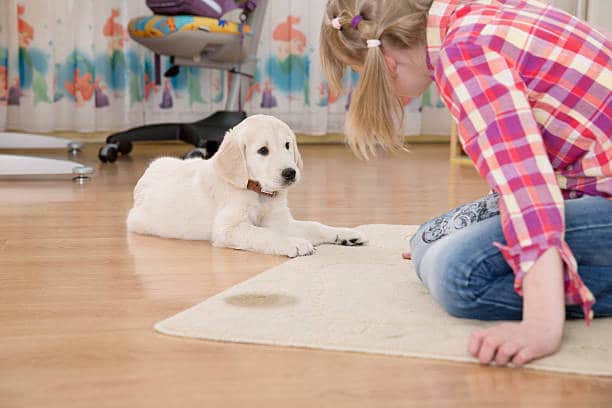Welcoming a new puppy to your home can bring a lot of joy to your world. Just looking at puppies is fun in its own way! They are goofy, floppy, innocent, and very adorable. And don’t forget about their heartwarmingly cute cuddles and the many social media pics that you can post for your new sweet puppy. Unfortunately, bringing home a new puppy also comes with a few stark realities like dealing with piles of poop and puddles of pee. That’s right, you should think about potty training your new puppy as soon as possible.
To ensure peaceful co-existence between your new puppy and other members of your family, you have to teach him to behave well—and if you value your floors and furniture, it starts with proper potty training.
One of the most common tools dog parents reach out for when housebreaking their puppies are puppy pee pads. While teaching your puppy to go potty outside right from the beginning is highly recommended, there are situations when pads make more sense. For instance, pee pads can come in handy in situations when it is a challenge to provide frequent potty breaks for your new puppy due to work commitments, living situations, or personal circumstances. Pads can also be used for unvaccinated puppies or for senior dogs that are sick or have mobility issues.
If you are planning to include pee pads in your puppy’s housetraining routine, here are a few tips and tricks on how to potty train a puppy on pads.
1. Pick a Potty Spot

Choose a spot where you want your puppy ‘do his business’ at. This is the spot where you will place the potty pad. Here are a few considerations to keep in mind when picking a potty spot:
- The spot should be over a hard floor or tile for easy cleaning. Avoid carpeted areas as much as possible to avoid a potential mess.
- Choose an area with considerably low foot traffic to avoid unnecessary disruption. Some dogs may need up to 5-10 minutes before they experience a bowel movement.
- Designate a spot that your puppy can use for long because moving your puppy’s pads around may interfere with his training.
The best spot is the bathroom because it is already small, making it easy to confine your puppy. Besides, with a bathroom, your puppy potty pad won’t be near food or in the way of entertaining your guests.
2. Introduce the Potty Pads
To help your puppy get used to the pee pad, give him an opportunity to see and sniff it. Allow him to walk and sit on the pad as you repeat the cue words you plan to use during the training period.
Consider using a leash to guide your puppy to the pad before giving a command. One of the most common mistakes that dog owners do is putting the potty pads in some corners in their homes and hoping that their puppies will find it. For your puppy to master you using the pads fast, you should show him what to do.
Be ready to use a lot of potty pads in the beginning. For instance, you may need to cover the potty spot with more than one pad before your puppy becomes accustomed to pooping or peeing on the pads.
3. Get Potty Pads On Cue
Once your puppy has become accustomed to the pads, you need to come up with a cue that can tell him what he needs to do. Without a cue, you may have to wait for your puppy for long whenever you take him to the new spot because he may take some time for him to figure out why you’ve taken him there.
Use words such as “go potty”, “get busy”, or “do business” every time he starts to pee. Avoid cue words like “good boy” or “good girl”, which you are probably already using to praise your puppy for good deeds because you might confuse him and even make him pee on the wrong places. Repeat the cue words several times a day until you can use the words to make the potty happen.
4. Understand When Your Puppy Is Likely To Potty
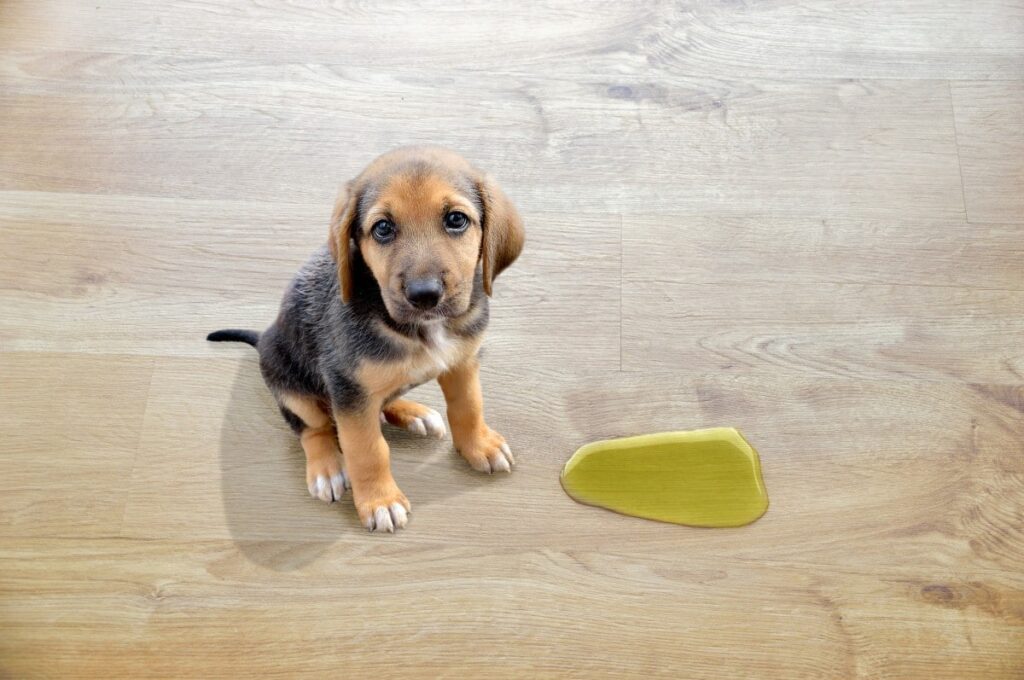
Like any other type of puppy potty training, to be successful with potty training a puppy on pads, you need to anticipate when your puppy is about to go potty. If it is your first time to potty train a dog, here are some key times and behaviors to watch out for:
- A puppy is likely to go to potty after waking up, eating, drinking, or playing. So, within 5-30 minutes after these events, be ready to direct your puppy to use the pads.
- After an event that may leave your puppy anxious or overly-excited (like after hearing thunder or firework or when meeting visitors), he is likely to lose his bladder control.
- Before your puppy goes to bed at night, consider taking him for a final bathroom break.
- Be ready to guide your puppy to the potty pad the moment he starts sniffing your floor or furniture, chewing things, or circling around as these behaviors may be a signal that he needs to go potty.
- A puppy may need a bathroom break in the middle of the night, especially between midnight and 3 pm. Keep in mind that before young puppies have proper control of their bladder, they need to go to potty as frequently as 20-30 minutes to 1 hour. Learn more on this post: How Long Can a Small Dog Hold Its Bladder Overnight?
Pro Tips
Set an alarm to go off every 1-2 hours and walk your dog to the peed pad every time he goes to see what happens. Well, this can be hectic to maintain throughout the day but it is necessary if you want your puppy to master his potty training.
Keep a chart of your puppy’s housetraining wins and losses. This way, you can figure out other important times of the day or night when he is likely to need to go potty.
5. Enhance the Training With A Crate
Dogs hate peeing or pooping where they sleep, so confining your puppy in a smaller space can go a long way in teaching him to hold his bladder a bit longer, which can enhance his training on pads. When you are just starting, crating your puppy is the best way to do this. Whenever you are not supervising your puppy, consider crating him. Just remember to lead him to the potty pad immediately you let him out. Most importantly, when you decide to crate a puppy for potty training, ensure that you take him to the potty pad as frequently as possible—after drinking, eating, playing, etc.
Related Post: 10 Best Collapsible Dog Crates
6. Leverage the Power of A Leash
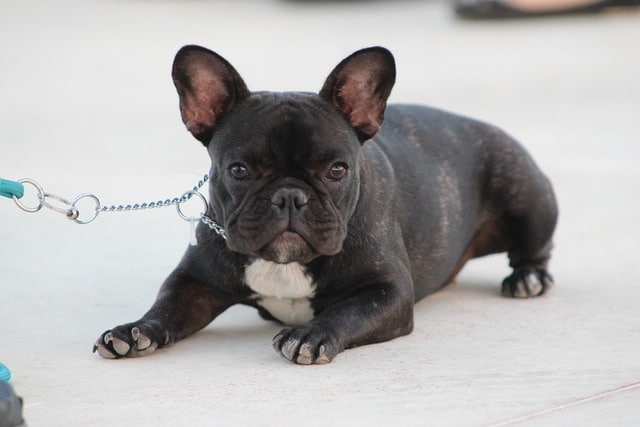
Besides crating, putting your puppy on a leash when you suspect that he’s about to go potty can enhance his pee pad training. The idea is simple: put your puppy on a leash until he pees or potty on the pad before letting him off to roam. If this is done repeatedly, your pup will begin to understand that whenever a leash is put on him while he’s indoors, he will need to potty or pee on the pad before being allowed to roam freely again in the house. Soon, you may not even need the leash—you will realize that the puppy is ready to poop or pee immediately you go near their confinement area so that they can win their freedom.
7. Reward
Praise and rewards are critical in helping your puppy understand how it is important to potty in the new pee pad. Praising and rewarding your puppy with a few treats after he finishes to potty on the potty pad can make a lasting impression on him and help him understand the right spot to do his business.
Remember to reward your puppy immediately he finishes emptying his bowel. Don’t reward him later as he may not understand why he is being rewarded. To ensure that your dog doesn’t wait for long, consider keeping the treats bag beside the potty area. If your puppy is easily distracted, the leash tip that we have covered above (point 6) can do the trick. Walk him to the pee pad while on a leash and only release him after he goes on the pad. The freedom to roam free will be a bonus reward.
8. Disinfect To Prevent More Accidents On The Wrong Places
To reduce the number of accidents in unwanted areas in your home, clean and disinfect the areas where they happen. Dogs love to do their business in the same spot over and over because they get attracted by the scent and pheromones in their urine. During the pee pad training process, strive to completely neutralize any scent from any accident that’s not on the pee pad.
We recommend that you use stain and urine cleaners that are designed to eliminate urine odor. Here are the best options: 15 Best Enzyme Cleaners for Dog Urine
Tips and warnings
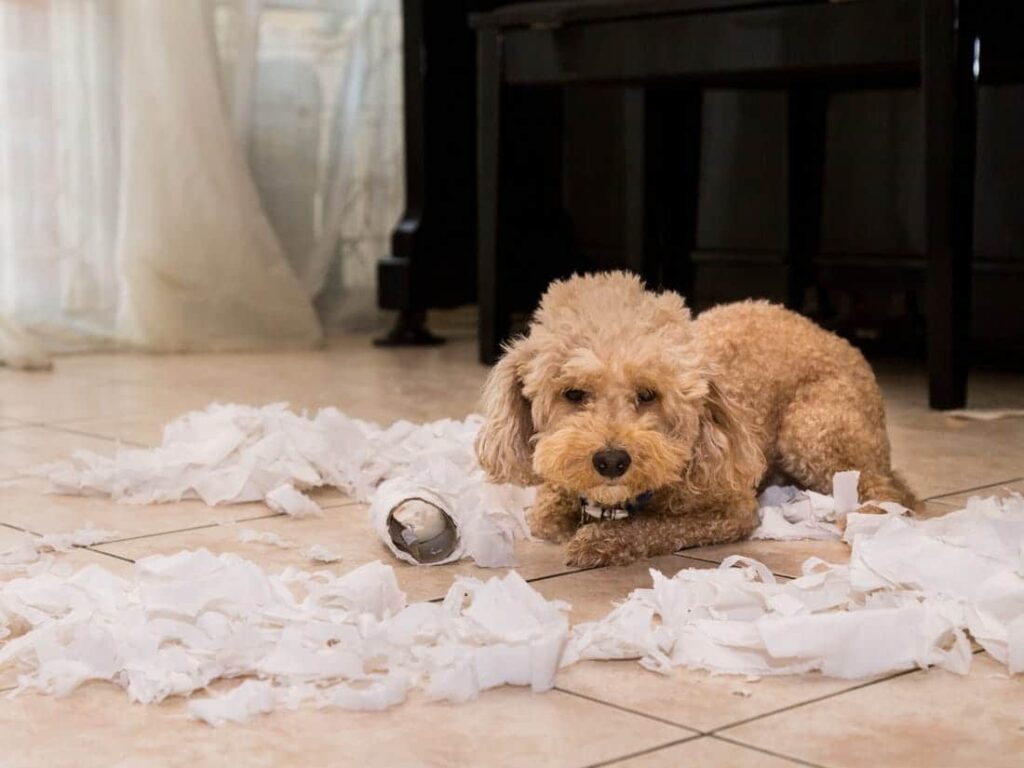
- Put soiled clothes or towels that your puppy has had accidents on over a new pee pad to attract your puppy to eliminate on the pad. Alternatively, use a commercial puppy pad training spray. Here are the best options: 7 Best Potty Training Sprays for Dogs
- Don’t allow your pup to sleep, play, or eat food on his pee pad because he may easily confuse the purpose of the pad.
- Don’t punish your puppy, yell, or make a big deal out of his accident as it will just scare him and distract him even more from what you are trying to get him to do right.
- If you have a dog that constantly needs pads or if you are out of the house most of the time, a washable dog pee pad could save you a lot of money in the long term, especially when compared to disposable options. Check this post for the best options: 15 Best Washable Dog Pee Pads
- Once your puppy has mastered to use pee pads, he may develop a surface preference for them and may not be ready to eliminate outdoors without proper re-training later in life. So, only train your puppy to eliminate indoors if it is going to be a life-long commitment.
- Avoid the temptation of changing the potty area or moving the puppy pad until your puppy becomes accustomed to it and doing his business on it consistently.
- When you decide to enhance the training with a crate, don’t leave the pee pad in the crate. Not only can it be a chewing hazard but it may also encourage your puppy to start eliminating in the crate.
- Puppies need to go potty very frequently. As such, they need very close supervision, especially at key times highlighted above—after eating, drinking, playing, and after a nap.
- Be patient with your puppy as some breeds are more challenging to potty train than others. Do some background research on your breed so that you know what to expect. Here is a good post you begin with: 10 Best Dog Breeds for Litter Box Training
Transitioning From Puppy Pads to the Outdoors
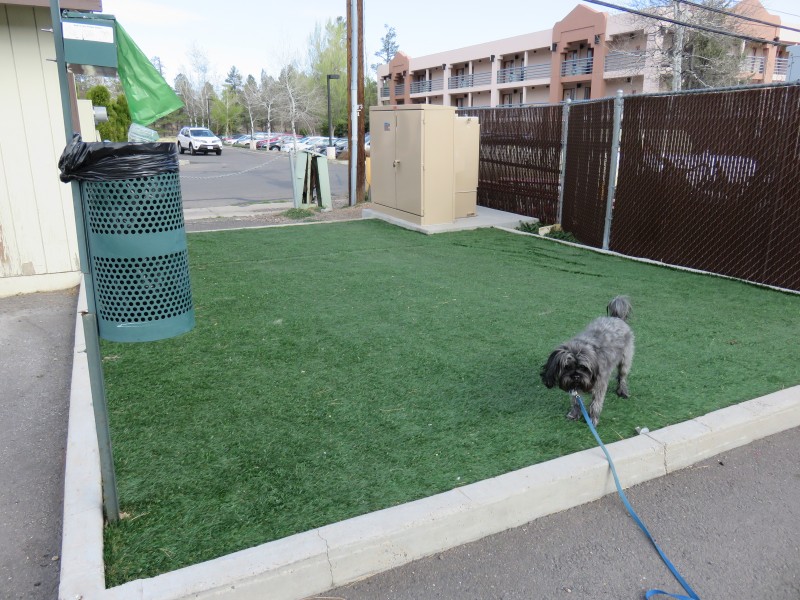
As hinted above, one of the biggest shortcomings of puppy pee pads is the fact that puppies get used to them. This implies that you may need to train your hound twice—to use the pad and to stop using it. Don’t fret; if you feel that your puppy is ready to potty outside after, you can re-train him.
In fact, we have some good news for you: when transitioning your puppy from pee pads to the outdoors, you can apply many of the tips that we have highlighted above. All you need to do is to take your puppy outside rather than to his pee pad. Here are a few tips that can come in handy:
- Move the pee pad close to the door each day. It is advisable to move it only a few inches a day so that you don’t confuse your puppy. A difference of about a foot in 1-2 days will suffice. Begin with towards the doors, then outside, then just outside the door, and slowly to your backyard where you want your puppy to eliminate.
- If you want your puppy to use artificial grass or the ground, consider decreasing the size of the potty pad once it is outside. Some puppies will master to potty outside fast, especially when you apply some of the tips we have highlighted. However, if your puppy is struggling, cut the puppy into smaller pieces until he learns to use the ground or artificial grass. Using tools like a fake fire hydrant may also help your puppy figure out where to direct his urine. Check the best options here: 8 Best Fire Hydrants for Dogs to Pee On
- Consider removing floor mats or throw rugs around the house or by your door during the transition period as some puppies may see them as a replacement of the pee pads and go on them. Only return the rugs after your puppy has acclimatized to the outdoor potty area only.
For more tips on how to train your puppy to poop or pee outside, check out this post: How to Potty Train a Puppy to Go Outside in 7 Easy Steps
Quality Dog Food matters during Training
One of the best ways of making pee pad training easy for you and your puppy is to combine the training with quality foods. If you feed your pup low-quality food with a lot of fillers like soy, corn or by-products, your puppy will eliminate more poop, which makes training harder. On the flip side, puppies fed on quality dog food will pee and poop less, making the training process easier and faster.
The nature of your dog’s poop may also have an impact on his pee pad training. Firmer, healthy poop makes training easier than softer poop. So, if puppy’s poop is too soft, have your local vet check for parasites. If he is clean, consider feeding him less food as too much food is known to cause looser stools in puppies.
Besides high-quality food, keep your puppy hydrated. If a puppy gets into a habit of drinking water on a regular basis, it will be easier for you to analyze his peeing patterns and figure out the right time or how frequently you should take him to the pee pad. Figuring your puppy’s peeing patterns can go a long way in helping you reduce the number of accidents in the wrong places.
Related Posts:
10 Best Step on Dog Water Fountains to Keep your Pup Hydrated
10 Best High Fiber Dog Foods for Small Breeds
Patience and Consistency Are Keys to Success
Successfully training your puppy to use pads takes time and a lot of effort but it is ultimately worth it if your puppy masters the training. So, be patient with your puppy—if he not picking up the training as you expected in the first couple of days, don’t give up. The process can take several weeks to master depending on your commitment and your dog breed.
And don’t be tempted to vary your training routine (like changing the potty pad brand, potty location, cue words, or frequency of trips to the pad) as it can confuse your puppy and set back your training progress.
Finally, ensure that you always write down as much information about the training process as possible. This added attention to detail will come in handy someday, especially when you visit a vet. By the way, you can easily do this using a Dog Printable Planner. With a planner, you can gather all information about your dog and put it in a binder. This way, you can reach out for it anytime you want. Besides, there are situations when you will need a sitter, a friend, a relative, or a neighbor to watch over your dog. When that happens, the person can use the information on the planner to best take care of the dog in your absence. Check out the printable here.
The Bottom line
Potty training a puppy to effectively use pads is a lot of work. Remember that puppies are like babies—they take time to learn something especially if they have never experienced it before. If anything, we wrote this post because we realized that countless dog owners were asking a lot of questions revolving around how to potty train a puppy on pads.
We believe that if you can combine the tips we’ve highlighted so far with patience and consistency, you should have a well potty-trained puppy in just a few weeks. Besides, potty training a puppy is always a great opportunity to bond with your new fur baby and set a stage for long-term love, trust, and respect.
Note that the tricks we have highlighted in this post are not exhaustive when it comes to training a puppy to use pads but can help you see drastic improvements for your puppy. Good luck in potty training your new family member with potty pads!
Related Posts:
15 Best Artificial Grass for Dog Potty (That Won’t Soak)
How to Build an Outdoor Dog Potty Area on Concrete
As an Amazon Associate, we may receive a small commission from qualifying purchases but at no extra cost to you. Learn more. Amazon and the Amazon logo are trademarks of Amazon.com, Inc, or its affiliates.

